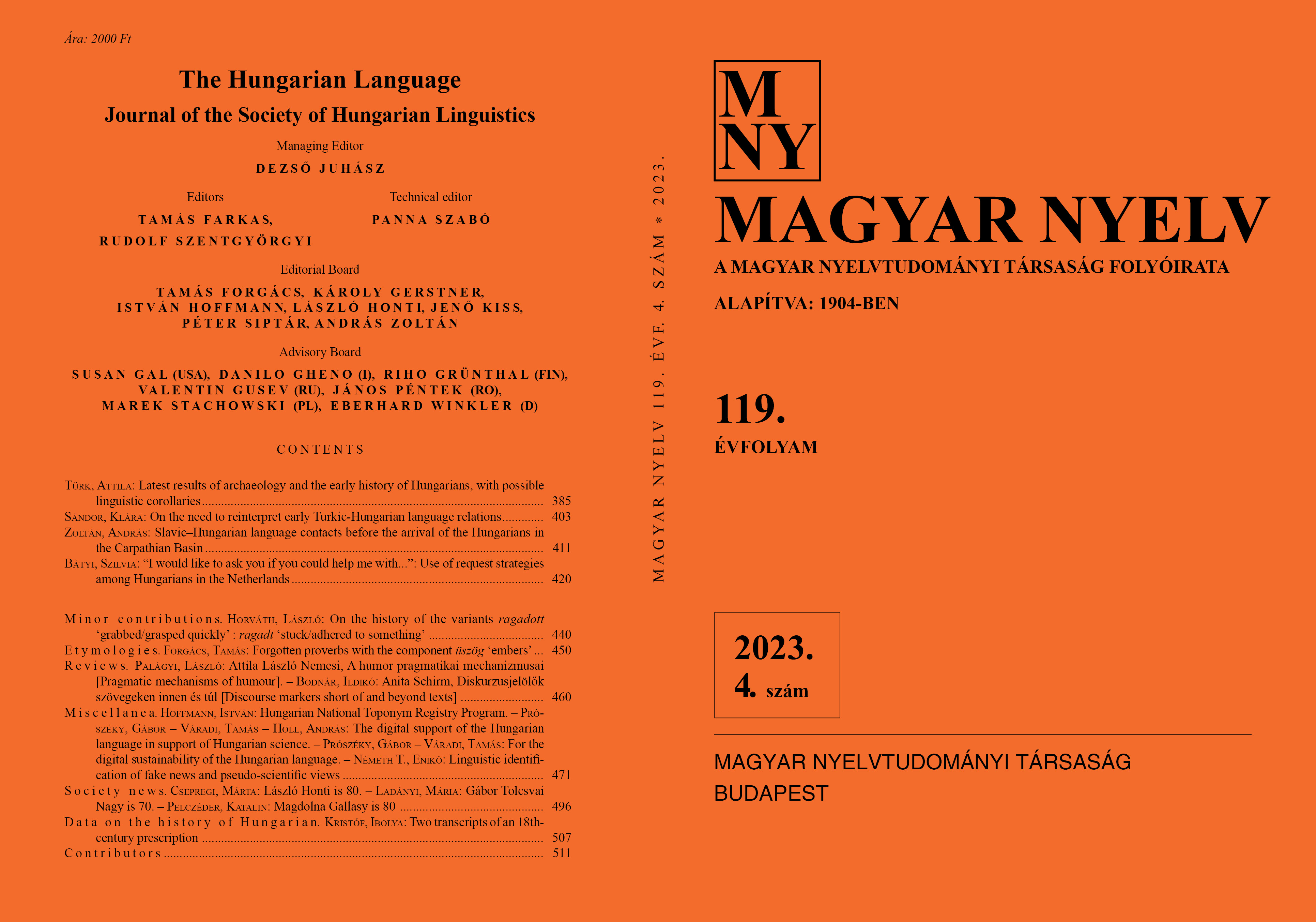Slavic–Hungarian language contacts before the arrival of the Hungarians in the Carpathian basin
DOI:
https://doi.org/10.18349/MagyarNyelv.2023.4.411Keywords:
language contact, East Slavic, borrowings, etymologyAbstract
The ancestors of the Hungarians came into contact with the ancestors of the Slavs at the time of the former’s presence in the East European Plain (9th century CE). While the ancestors of the Hungarians lived in the steppe zone of the East European Plain, the Hungarian language was open to its first Slavic elements from East Slavic dialects. Researchers consider these to include words such as tanya ‘farmstead’ (< Old Russian tonja), naszád ‘a type of vessel’ (< ORu nasadъ), and halom ‘hill, heap’ (< ORu xъlmъ). There are reasons to include here the words lengyel < lengyen ‘Pole’, szégye ‘fishing tackle’ (< ORu sěža), and varsa ‘fish trap’ (< ORu verša < *vьrša). However, because formal criteria for the great majority of early Slavic elements in Hungarian are lacking, it is difficult to determine with any degree of certainty which ones are due to an East Slavic dialect at the time of migration of the Hungarians in the Black Sea steppe region. Consequently, the East Slavic character of these early Slavic borrowings in Hungarian remains unprovable. The most reliable borrowing from East Slavic before the migration to the Carpathian basin is the ethnonym lengyel (< lengyen) ‘Pole’, which goes back to the Slavic tribal name *lędjan(e) and is also attested in the writing of Constantine Porphyrogenitus and located by him in the Subcarpathian region. This tracks well with the known path of the Hungarians across the Carpathian Mountains on their way to the Carpathian basin. However, we have the example of the Old Serbian Leđanin ‘Pole’. Consequently, it is possible that the Hungarians did not become acquainted with the name of this tribe “en route” while in contact with the ancestors of the Eastern Slavs, but encountered it later, in the Carpathian basin, as the name could only have been familiar to the Slavophone people located there. The number of borrowings from East Slavic in Hungarian before the arrival of the Hungarians in the Carpathian basin (around 895 CE) is not large and is limited only to, at best, a handful of lexemes.
Downloads
Published
Issue
Section
License
Copyright (c) 2023 András Zoltán

This work is licensed under a Creative Commons Attribution-NonCommercial-NoDerivatives 4.0 International License.
Magyar Nyelv is a Diamond Open Access periodical. Documents can be freely downloaded and duplicated in an electronic format, and can be used unchanged and with due reference to the original source. Such use must not serve commercial purposes. In the case of any form of dissemination and use, Hungarian Copyright Act LXXVI/1999 and related laws are to be observed. The electronic version of the journal is subject to the regulations of CC BY-NC-ND (Creative Commons – Attribution-NonCommercial-NoDerivatives).
The journal permits its authors, at no cost and without any temporal limitation, to make pre-print copies of their manuscripts publicly available via email or in their own homepage or that of their institution, or in either closed or free-for-all repositories of their institutions/universities, or other non-profit websites, in the form accepted by the journal editor for publication and even containing amendments on the basis of reviewers’ comments. When the authors publicize their papers in this manner, they have to warn their readers that the manuscript at hand is not the final published version of the work. Once the paper has been published in a printed or online form, the authors are allowed (and advised) to use that (post-print) version for the above purposes. In that case, they have to indicate the exact location and other data of the journal publication. The authors retain the copyright of their papers; however, in the case of an occasional secondary publication, the bibliographical data of the first publication have to be included.



